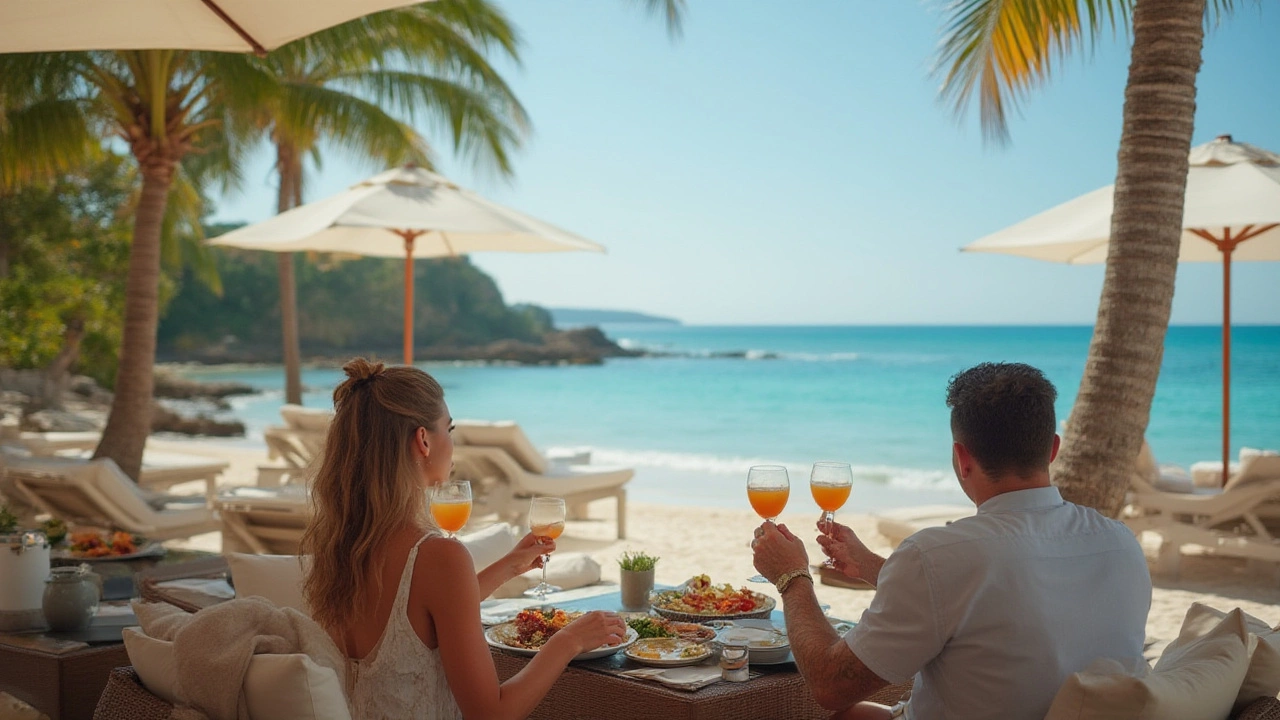All-Inclusive Hotel Meaning: Is Food Really Free at Resorts?
 Jul, 6 2025
Jul, 6 2025
Picture stepping into a grand lobby, tired but excited, knowing you won’t have to pull out your wallet for every meal or drink. Is it a dream, or are all-inclusive hotels truly the promised lands of unlimited free food? Now, before you book that escape and start daydreaming about bottomless buffets, let’s get honest about what all-inclusive really means, especially when it comes to food.
What Does All-Inclusive Actually Cover?
First off, the phrase "all-inclusive hotel" rings with promise, but it’s not a magic spell where anything goes. The concept, which flourished in the Caribbean and Mexico during the late 20th century, was built to lure travelers with ease: you pay once and—voilà—food, drinks, and activities are (mostly) covered. But here’s the real scoop: the definition of "all-inclusive" can be as slippery as a piña colada in the tropical heat. At most well-known resorts, yes, meals are included—breakfast, lunch, dinner, and often snacks. Many chains like Sandals or Club Med even offer gourmet dining across multiple on-site restaurants without extra charge. But, not everything is always unlimited or free. Prime steakhouse nights might carry a surcharge, certain seafood dishes could be extra, and don’t even get me started on the “imported wine and spirits.”
The food itself varies a lot. Some resorts pride themselves on fresh, local cuisine in beautiful settings, while others might feel more like an endless cafeteria line. Buffets tend to be the backbone—think omelet stations, taco corners, pasta bars—plus a few à la carte spots that often require advance reservations. In bigger resorts, restaurants have themes: Italian, Asian, Mexican, seafood grills, with menus rotating nightly to stave off buffet boredom. And yes, at most places, fueling up at these buffets or snack shacks throughout the day is absolutely part of the deal. You’ll find nachos by the pool, ice cream stands, midnight pizza—just waltz up and ask, no wallet required.
Here’s a fun angle: some properties even include 24-hour room service. You could be watching the sunrise from your balcony with pancakes showing up at your door, no tip expected. But always double-check, because a few budget or European “all-inclusives” might skip it—or only offer room service for a fee. And watch the drink menu too: local beer or standard cocktails are typically included, but top-shelf whiskey or that fancy bottle of champagne? You’ll see a price tag. Want a coconut cracked open and sipped at the beach bar? That’s usually included, but always best to ask first. Don’t let surprise upcharges ruin your vibe.
Kids’ meals are a big plus at family-friendly all-inclusives. Many have entire restaurants or buffets devoted to the little ones, with chicken nuggets, pancakes, and elaborate dessert spreads. You can roll in at nearly any hour and find kid-friendly snacks ready to go, saving a ton of headache for parents who’ve dealt with “hangry” kids on regular hotels trips. But in contrast, high-end adults-only spots may opt for refined (read: smaller) menus with fewer all-day snack options. Some even charge extra for "premium" poolside bites after certain hours—so hungry night owls take note.
The Fine Print: What’s Not Included
This is where reality checks in. The three words travel agents love: Read. The. Fine. Print. It’s tempting to assume everything’s covered, but there’s always a few sneaky extras. For starters, not every hotel in the world agrees on what “all-inclusive” means. In Europe, the term sometimes stretches only to three daily meals, with drinks limited or only available at mealtimes. Even in Mexico or the Caribbean, some “all-inclusive light” packages give access to buffets but charge for specialty restaurants or top-shelf drinks.
If you’ve got a soft spot for lobster, high-end steak, sushi, or fine dining, ask about upcharges before you sit down. At some resorts, premium menu items—like filet mignon or a whole grilled lobster—are marked as "market price" or have a little star next to them, and your final bill won’t be a happy surprise. Specialty restaurants (sometimes with dress codes and reservations required) can also tack on per-person surcharges or limit reservations during your stay—meaning you’ll get only one romantic Italian dinner, not three.
Drinks are another story. Standard cocktails, house wines, and local beers usually slide into the all-inclusive package, often with abundant pool and beach bars. Feeling fancy? Expect extra fees if you want imported champagne, craft cocktails, artisanal gin, or special tequila tastings. Minibar restocks in your room are sometimes daily and included—but at some resorts, you get only water and soda gratis, while alcohol costs extra. Even sparkling bottled water might be a "luxury" upgrade at certain European properties, so check ahead if you’re picky about hydration.
Room service further exposes the cracks in “free everything.” At luxury chains like Secrets or Iberostar Grand, you can order just about anything, at any hour, without limits. But budget chains (or those trying to keep costs down) might offer only a limited menu after midnight—or hit you with a “delivery fee” per order, plus a suggested tip. Speaking of tips, North American resorts usually bake them into your room rate, but tipping extra at bars or for room service is still common and sometimes expected. In Europe, tips are rarely included, and some staff absolutely count on them, so have a few euros handy, even if your bill is “prepaid.”
Some resorts bundle activities and entertainment: think beach yoga, tennis, stand-up paddleboards, pool parties, or even nightly shows. Others limit these perks—like only basic sports or board games included. Motorized water sports? Spa treatments? Rounds of golf? Almost never in your base rate. So if you dream of daily massages or waterskiing before lunch, budget accordingly.

Tips to Maximize Your All-Inclusive Food Experience
Let’s talk about how to really get the most from your all-inclusive stay—especially the food. After all, you want more than a week of soggy fries and watery colas, right? First, research the resort’s dining options before you book. Look past the glossy website photo of an artfully arranged dessert plate. Dive into traveler reviews (real ones, not the obviously-fake five stars) that mention the freshness, variety, and flavor of the buffets, as well as wait times and reservation systems for à la carte dining. Some all-inclusive resorts are known for gourmet food—think Le Blanc Spa Resort in Cancun or Grand Velas Riviera Maya—while others lean on quantity over quality.
Once you arrive, scope out your options before meal rushes hit. Buffets get crowded, and freshly replenished dishes go fast. Show up when the doors open for the best picks—especially if you’re eyeing the crab legs or fresh sushi. If there are specialty restaurants, lock in reservations on Day 1. Some resorts let you book all your dinners for the week at check-in. Don’t put it off or the best time slots (and tastiest menus) might be gone by Day 3.
If you love to snack, don’t assume all snack bars are obvious. Some gems are tucked away—like ice cream parlors hidden behind a pool bar or late-night taco shacks near the lobby. Ask staff directly for their favorite under-the-radar eats or unique snack times. They’ll usually spill the best secrets if they know you’re interested (and polite).
Remember, you’re not required to eat everything in sight just because it’s included. Tempting, I know. See buffet offerings as a way to try new dishes without committing to a whole plate—take small amounts and sample away. Fancy dessert? Split it and share. Try something daring—go for the ceviche, or that local stew that’s out of your comfort zone. You’re not paying extra, so why not?
Drinks follow the same logic. Bars may have a "house cocktail," so ask what’s on special. Some bartenders quietly offer premium pours if you make friends or visit during slower hours. Don’t be shy about requesting your favorites, but don’t expect every spirit or brand to be included. If you’re a big coffee or smoothie lover, check whether specialty cafés are free—at certain high-end resorts, those craft lattes and blended drinks really are part of the package, so take advantage.
One more thing: resort dress codes catch people off guard. Buffets are flip-flop heaven, but many à la carte dinners require "smart casual" (think sundresses, closed-toe shoes, collared shirts) and won’t let you in with swimwear. Check rules before you pack, or risk missing the best meals.
Interesting Facts About All-Inclusive Resort Dining
Did you know that the world’s first true all-inclusive resort opened back in 1950 by Belgian water polo player Gérard Blitz, who dreamed up Club Med as “village-style” vacationing? Back then, guests bunked in beach huts and dined communally, meaning the idea of multiple sit-down restaurants was still a far-off fantasy. The gourmet revolution came much later, with luxury brands pushing the bar higher each year—to the point that today’s all-inclusives are sometimes indistinguishable from high-end city hotels (except, you know, for the unlimited free food).
Food waste at these resorts is a real challenge. A study by the Sustainable Hospitality Alliance found that buffet-driven hotels can generate almost twice as much food waste per guest as à la carte restaurants, simply because people love to pile their plates high, “just in case.” That’s changing, though: newer all-inclusives often work with local farmers, host zero-waste cooking classes, or offer “live cooking stations” to combat excess. Ask at check-in if your resort participates in sustainability efforts—some let you join in, like picking herbs for the nightly pasta station or learning to make ceviche from scratch.
Watch for foodie events that some all-inclusives are now famous for—food festivals, celebrity chef pop-ups, or wine-pairing dinners. High-end chains in Mexico and the Caribbean regularly host weeklong gastronomy festivals featuring Michelin-star chefs (especially in the cooler tourist months). These might be included for all guests, or require a paid upgrade. Either way, they add excitement and are worth planning your trip around if you love culinary adventures.
Traveling with allergies or special diets? Most all-inclusives now offer solid options for vegetarians, vegans, gluten-free, and kosher or halal menus. Pro tip: contact the resort in advance and get confirmation in writing about what they can do. Some will even develop a tailored meal plan just for you or provide a dedicated chef for severe allergies. You’ll eat better, feel less anxious, and maybe get to try some dishes you’d never order at home.
One last twist—some high-end resorts offer “dine around” options. You get vouchers or access to several restaurants outside your own hotel, usually in the same brand family or nearby partner hotels. This lets you explore local flavors and scenery while still staying in the all-inclusive comfort bubble. Don’t be shy—ask if your resort participates. Variety is half the fun.